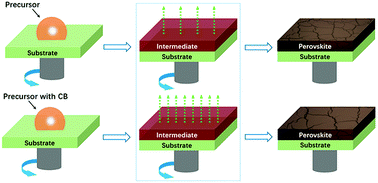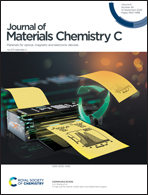Improving the performance of inverted two-dimensional perovskite solar cells by adding an anti-solvent into the perovskite precursor†
Abstract
Ruddlesden–Popper type two-dimensional (2D) perovskite solar cells (PSCs) have been intensively studied because of their high power-conversion-efficiency (PCE) and long-term stability. In this work, we improved the performance of 2D PSCs by adding an anti-solvent (chlorobenzene) into the perovskite precursors. The use of chlorobenzene could promote the crystallization of the 2D perovskite by accelerating the formation of the perovskite nuclei. Consequently, the quality of the 2D perovskite film was improved with enhanced crystallinity, enlarged grains and reduced pinholes. By adding 20% chlorobenzene into the precursor, the average PCE of the 2D PSCs was significantly improved from 9.83 to 12.91%, with simultaneous enhancements in open-circuit voltage, short-circuit current density and fill factor. Additionally, the PCE degradation of the 2D PSCs was also reduced from 21 to 13% after a 15-day duration, indicating the improved long-term stability. The best device processed from the chlorobenzene-added precursor exhibited the highest PCE of 13.35% with a stable power output and negligible hysteresis. Our research provides a simple and effective way for improving the performance of 2D PSCs.



 Please wait while we load your content...
Please wait while we load your content...